On May 18, the 44th International Museum Day, the renovated Pearl Buck Memorial House in Nanjing University (NJU) was officially reopened to the public. Nanjing, the capital city of Jiangsu Province, was also chosen as the 2020 China Main Venue with an annual theme of “Museums for Equality: Diversity and Inclusion”.
Pearl Buck was a great writer, a dedicated professor, a diligent humanitarian, and above all, a devout Christian. She was the first American woman to be awarded both the Pulitzer Prize in 1932 and Nobel Prize for literature in 1938, for her epic portrayal of Chinese peasant life and for the biographies of her parents in the book The Good Earth.
Born in Virginia in 1892, Pearl was brought to Zhenjiang, a southern city in China, by her missionary parents at the age of four months. In a biography on Pearl Buck, A Home in History: The Pearl S. Buck House National Historic Landmark, the writer states that her parents preferred to live among the Chinese and not in the missionary compound. "Thus, she grew up in close contact with the Chinese people, speaking Chinese, playing with Chinese children, visiting their homes, listening to their ideas and absorbing their culture. These experiences helped to develop the mind and the imagination of an alert, intelligent child, who later used this material in her novels."
In 1917, she married John Lossing Buck, an American agricultural missionary. Four years later, they moved to Nanjing, where they both embarked on careers in education. John taught agriculture techniques and farm management while Pearl focused on foreign language and literature at Jinling University, which was merged into NJU in 1952.
Pearl began to write in 1922, and most of her creations were closely related to China, exhibiting her deep understanding of the lives and beliefs of ordinary Chinese people. In addition to writing, she also translated Chinese classics, hoping that European and American countries would be able to break their negative stereotypes of China, especially during a time when China was weak and vulnerable, going through a seemingly impossible fight against Japanese invaders.
In addition to her many literary achievements, Pearl Buck was also a driving force in humanitarian causes. She was a longtime advocate of cross-cultural understanding and racial harmony as a means of achieving world peace.
On May 19, 2012, on the 110th anniversary of Nanjing University, the former residence of Pearl Buck, located on the campus of NJU, was renamed the Pearl Buck Memorial House with the NJU Archives in charge. According to the latest report on the official Wechat account of John Rabe and the International Safety Zone Memorial Hall in NJU, various groups worked together to transform and improve the museum’s environment.
Last year, the Institute for the Study of American Art in China and The Student Exhibition of American Art History was held at the Pearl Buck Memorial House. Poets and professors from Germany visited, and a group from China’s Central Committee leadership also came to investigate the museum. The Memorial House has four exhibition rooms: Pearl Buck’s life story, Pearl Buck and NJU, Pearl Buck’s Literary Achievements, The Good Earth, and reconstruction of one of the bedrooms, the parlor, and other rooms. There are also screens where visitors can view films and a multimedia conference room that is reproduced to depict scenes of Pearl Buck’s life.












